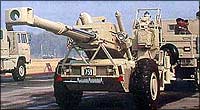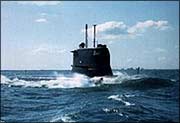The Rediff Special/ Josy Joseph

How a nation was looted
Nothing seems to deter the middlemen who formulate India's defence deals -- not high profile probes, not political crackdowns, not spycams... They know that political clout and money - of which they seem to have inexhaustible supply -- will always buy them a way out.
Take the case of the HDW submarines and the Bofors guns. The firms which produce them, their front companies and the middlemen involved continued to draw massive profits from the Indian armed forces even after they were blacklisted and banned by the Rajiv Gandhi government. Since then, governments have changed in New Delhi, but nothing has changed the Indian fortunes of the two arms giants.
When blacklisting Bofors, the then government did not seem to have taken into account the fact that the Indian Navy was already using the Bofors guns in some of its ships and that, in future, these guns and those used by the Army would need spares.
 Unable to deal directly with the two firms, the armed forces had no choice but to approach middlemen and procure these spares at exorbitant prices. Curiously, HDW owned 50 per cent of the firm that was chosen to supply the submarines spares. Besides, the Navy had been procuring even basic items such as lubricating oil for the Bofors guns through middlemen at heavily inflated prices, while the Army has been using them to procuring spare parts. "We had no option," confesses a senior officer.
Unable to deal directly with the two firms, the armed forces had no choice but to approach middlemen and procure these spares at exorbitant prices. Curiously, HDW owned 50 per cent of the firm that was chosen to supply the submarines spares. Besides, the Navy had been procuring even basic items such as lubricating oil for the Bofors guns through middlemen at heavily inflated prices, while the Army has been using them to procuring spare parts. "We had no option," confesses a senior officer.
The deal with Bofors included a transfer of technology agreement, but the government did not follow up on it. Nor did it procure other items which were already paid for. A mute witness to the sorry Bofors saga is the stretch of desolate land near Kolar in Karnataka; it was acquired to build a factory complex for manufacturing the Bofors guns.
The HDW tale just as sordid. HDW was banned before the Navy received the complete drawings and NATO identification numbers for spares for the the SSK class submarine. This meant the spares were only identifiable through Technical Manual References, which only HDW and its men could understand. After the ban, HDW's contractual obligations were passed on to Marlog, which is jointly owned by HDW and Ferrostal, a German steel maker.
It was Rear Admiral S V Purohit who first exposed Marlog's staggeringly high profit margin and the Navy's lack of control in the matter. By then, it was time for midlife refit of the first HDW submarine, INS Shishumar. Yet, Marlog remained the sole supplier of HDW spares.
There are documents, and written complaints from serving officers, linking Marlog with Admiral SM Nanda, the former navy chief who was raided by the CBI for his alleged involvement in the HDW scandal. Nanda denies any link to Marlog, but says he did float a firm for HDW contract consultations in the 1980s.
Files in the possession of rediff.com prove no attempt was made to go in for open tenders before the refit of INS Shishumar. Germany is an open market economy and open tenders would have elicited competitive prices, as was proved later.
After Purohit took over as Assistant Chief of Logistics in July 1994, a mammoth effort was launched to identify the HDW submarine's spares. But, since India was denied the NATO code numbers, it was virtually impossible to do so. Several spares carried code numbers only HDW and, obviously, Marlog could identify.
 Some spares, though, were identified and the Navy floated an open tender. Many German firms, including some owned by the German government itself, responded. Marlog, which did not like this development, refused to quote for several of these items which, unfortunately, only amounted to 20 per cent of the Navy's needs.
Some spares, though, were identified and the Navy floated an open tender. Many German firms, including some owned by the German government itself, responded. Marlog, which did not like this development, refused to quote for several of these items which, unfortunately, only amounted to 20 per cent of the Navy's needs.
But the cat was out of the bag. A comparative price chart for items Marlog had supplied in the last five years, and quoted in the later tender for the midlife refit, shows how exaggerated their prices were. And how the Navy, without accountability or counterchecks, had literally given away millions of rupees to Marlog.
| Item |
Midlife refit price |
Previous purchase price |
| Piston rod |
Rs 98,420 |
Rs 626 |
| Valve cover seat ring |
Rs 7,539 |
Rs 436 |
| Cylindrical pin |
Rs 178 |
Rs 46.25 |
| V Ring |
Rs 129 |
Rs 28.50 |
| Bearings |
Rs 3,056 |
Rs 2,030 |
| Bush |
Rs 958 |
Rs 505 |
| Cone |
Rs 1,243 |
Rs 144 |
| Drive rod antenna, II stage |
Rs 4,37,383 |
Rs 15,648 |
| Synchro box (complete) |
Rs 82,325 |
Rs 1,030 |
One must keep in mind the sale was from a country that had single digit inflation to another country that almost always had single digit inflation. What was worse, very few items required for the HDW submarines were procured locally. As a result (shown in the following chart), the nation again lost a lot of money.
| Item |
Marlog's price |
Local price |
| Flange |
Rs 1,64,712 |
Rs 3.50 |
| Hexagonal screw |
Rs 15,240 |
Rs 16 |
| Gasket |
Rs 13,760 |
Rs 195 |
| Locking plate |
Rs 8,844 |
Rs 90 |
| Washer |
Rs 8,328 |
Rs 9 |
| Cylindrical screw |
Rs 4,596 |
Rs 18 |
Marlog also quoted for some items that were available with other German firms. Here is a comparative chart, with prices in Deutsche Marks, that speaks for itself.
| Item |
Marlog price |
Lowest rate quoted |
| O Ring |
DM 298.50 |
DM 0.30 |
| Sound absorb, bulkhead penetration |
DM 20,590.50 |
DM 25.41 |
| Counter sunk screw |
DM 112 |
DM 0.30 |
| Backup ring |
DM 447.50 |
DM 1.50 |
| Circlip |
DM 4,842.50 |
DM 40 |
| Cylindrical pin |
DM 21 |
DM 0.22 |
| Hex screw |
DM 104 |
DM 2 |
ALSO SEE:
Refitting the INS Shakti
The Russian connection
Return to How a nation was looted
Design: Dominic Xavier
The Rediff Specials